
The Qara Khitai, or Kara Khitai, also known as the Western Liao, officially the Great Liao, was a Sinicized dynastic regime based in Central Asia ruled by the Khitan Yelü clan. The Qara Khitai is considered by historians to be an orthodox dynasty of China, as is the case for its predecessor the Liao dynasty. The dynasty was founded by Yelü Dashi, who led the remnants of the Liao dynasty from Manchuria to Central Asia after fleeing from the Jin dynasty conquest of their homeland in northern China. The empire was usurped by the Naimans under Kuchlug in 1211; traditional Chinese, Persian, and Arab sources consider the usurpation to be the end of the dynasty, even though the empire would not fall until the Mongol conquest in 1218.
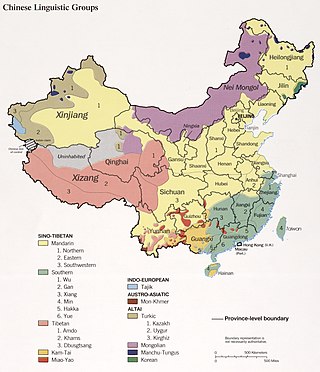
There are several hundred languages in China. The predominant language is Standard Chinese, which is based on central Mandarin, but there are hundreds of related Chinese languages, collectively known as Hanyu, that are spoken by 92% of the population. The Chinese languages are typically divided into seven major language groups, and their study is a distinct academic discipline. They differ as much from each other morphologically and phonetically as do English, German and Danish, but meanwhile share the same writing system (Hanzi) and are mutually intelligible in written form. There are in addition approximately 300 minority languages spoken by the remaining 8% of the population of China. The ones with greatest state support are Mongolian, Tibetan, Uyghur and Zhuang.
Khitan or Kitan, also known as Liao, is a now-extinct language once spoken in Northeast Asia by the Khitan people. It was the official language of the Liao Empire (907–1125) and the Qara Khitai (1124–1218).
Khitan scripts may refer to one of two mutually exclusive scripts used by the Khitan people during the 10th–12th centuries:
Khitan or Khitai may refer to:

The Khitan large script was one of two writing systems used for the now-extinct Khitan language. It was used during the 10th–12th centuries by the Khitan people, who had created the Liao Empire in north-eastern China. In addition to the large script, the Khitans simultaneously also used a functionally independent writing system known as the Khitan small script. Both Khitan scripts continued to be in use to some extent by the Jurchens for several decades after the fall of the Liao dynasty, until the Jurchens fully switched to a script of their own. Examples of the scripts appeared most often on epitaphs and monuments, although other fragments sometimes surface.

An undeciphered writing system is a written form of language that is not currently understood.
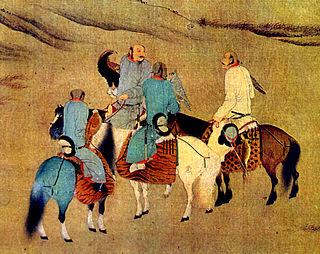
The Khitan people were a historical nomadic people from Northeast Asia who, from the 4th century, inhabited an area corresponding to parts of modern Mongolia, Northeast China and the Russian Far East.
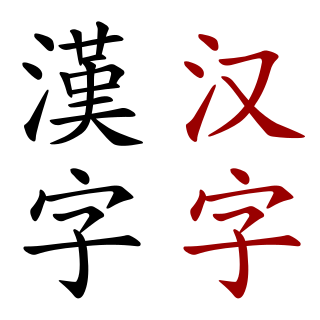
The Chinese family of scripts are writing systems descended from the Chinese oracle bone script and used for a variety of languages in East Asia. They include logosyllabic systems such as the Chinese script itself, and adaptations to other languages, such as kanji (Japanese), Hanja (Korean), chữ Hán and chữ Nôm (Vietnamese) and Sawndip (Zhuang). More divergent are Tangut, Khitan large script, and its offspring Jurchen, as well as the Yi script, which were inspired by Chinese although not directly descended from it. The partially deciphered Khitan small script may be another. In addition, various phonetic scripts descend from Chinese characters, of which the best known are the various kana syllabaries, the zhuyin semi-syllabary, nüshu, and some influence on hangul.

The Jurchen script was the writing system used to write the Jurchen language, the language of the Jurchen people who created the Jin Empire in northeastern China in the 12th–13th centuries. It was derived from the Khitan script, which in turn was derived from Chinese. The script has only been decoded to a small extent.

The Khitan small script was one of two writing systems used for the now-extinct Khitan language. It was used during the 10th–12th century by the Khitan people, who had created the Liao Empire in present-day northeastern China. In addition to the small script, the Khitans simultaneously also used a functionally independent writing system known as the Khitan large script. Both Khitan scripts continued to be in use to some extent by the Jurchens for several decades after the fall of the Liao dynasty, until the Jurchens fully switched to a script of their own. Examples of the scripts appeared most often on epitaphs and monuments, although other fragments sometimes surface.
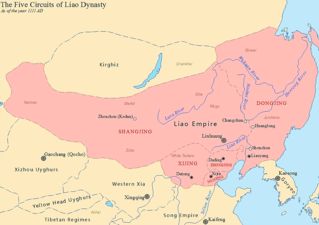
The Liao dynasty, also known as the Khitan Empire, officially the Great Liao, was an imperial dynasty of China that existed between 916 and 1125, ruled by the Yelü clan of the Khitan people. Founded around the time of the collapse of the Tang dynasty, at its greatest extent it ruled over Northeast China, the Mongolian Plateau, the northern part of the Korean Peninsula, southern portions of the Russian Far East, and the northern tip of the North China Plain.

The Memorial for Yelü Yanning (耶律延寧) is the oldest known Khitan inscription of significant length and for now the oldest major written attestation of a Mongolic language. Dated 986, it is written in the Mongolic Khitan language using the Khitan large script. With 19 lines and 271 characters it was found in 1964 at Baimu Mountain, Chaoyang County, Liaoning, China. and is now kept in the Liaoning Province Museum, China.
Aisin-Gioro Ulhicun is a Chinese linguist of Manchu ethnicity who is known for her studies of the Manchu, Jurchen and Khitan languages and scripts. She is also known as a historian of the Liao and Jin dynasties. Her works include a grammar of Manchu (1983), a dictionary of Jurchen (2003), and a study of Khitan memorial inscriptions (2005), as well as various studies on the phonology and grammar of the Khitan language.
Jin Guangping or Aisin-Gioro Hengxu (1899–1966) was a Chinese linguist of Manchu ethnicity who is known for his studies of the Jurchen and Khitan languages and scripts.
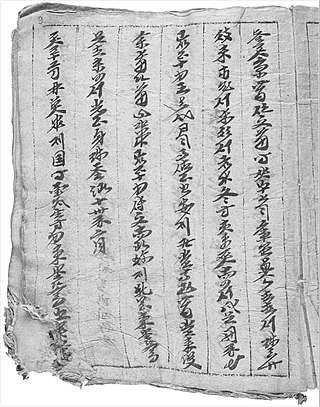
Nova N 176 is an undeciphered manuscript codex held at the Institute of Oriental Manuscripts (IOM) of the Russian Academy of Sciences in Saint Petersburg, Russia. The manuscript, of uncertain provenance, entered the collection of the IOM in 1954, and for more than fifty years nobody was able to identify with certainty what language or script the text of the manuscript was written in. It was only in 2010 that IOM researcher Viacheslav Zaytsev was able to demonstrate that the manuscript is written in the Khitan large script, one of two largely undeciphered writing systems used for the now-extinct Khitan language during the 10th–12th centuries by the Khitan people, who founded the Liao Empire in north-eastern China.
The Jaruud are a Southern Mongol subgroup in Jarud Banner, China.

The Liao dynasty was a Khitan-led dynasty of China that ruled over parts of Northern China, Manchuria, the Mongolian Plateau, northern Korean Peninsula, and what is modern-day Russian Far East from 916 until 1125 when it was conquered by the Jin dynasty. Remnants of the Liao court fled westward and created the Western Liao dynasty which in turn was annexed by the Mongol Empire in 1218.
Khitan Small Script is a Unicode block containing characters from the Khitan small script, which was used for writing the Khitan language spoken by the Khitan people in northern China during the Liao dynasty.












